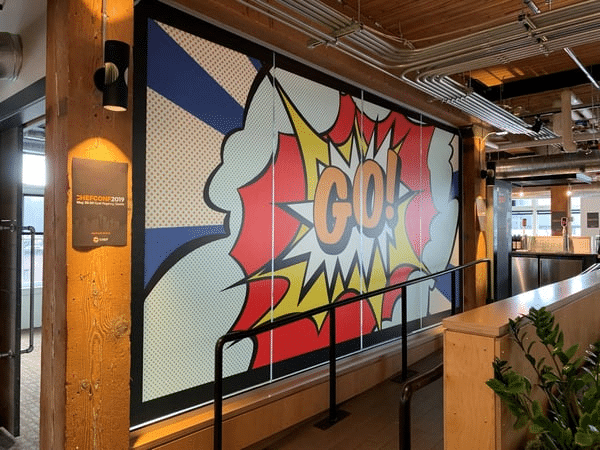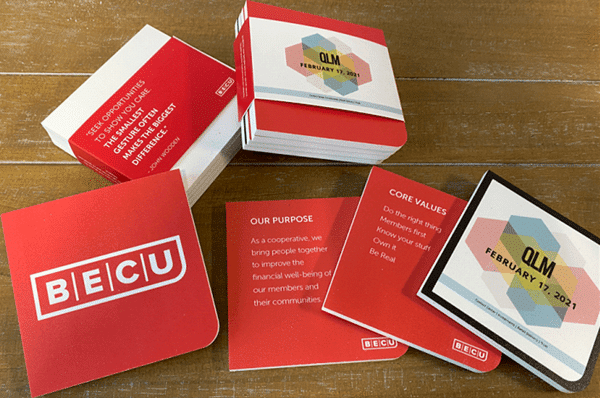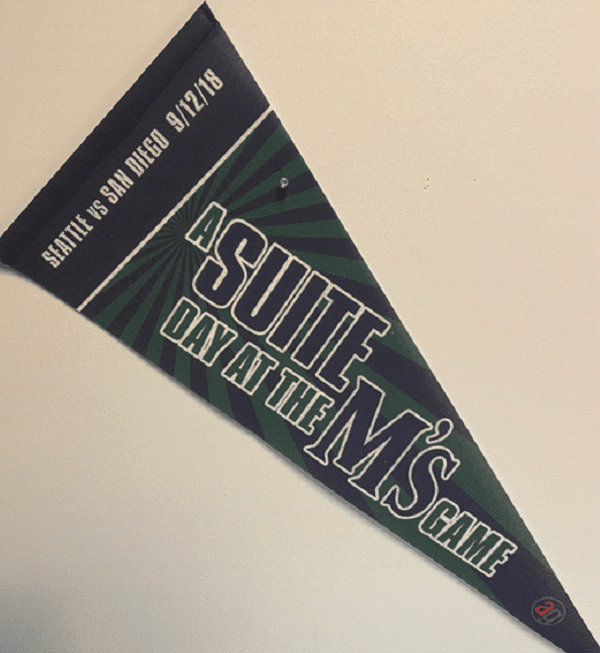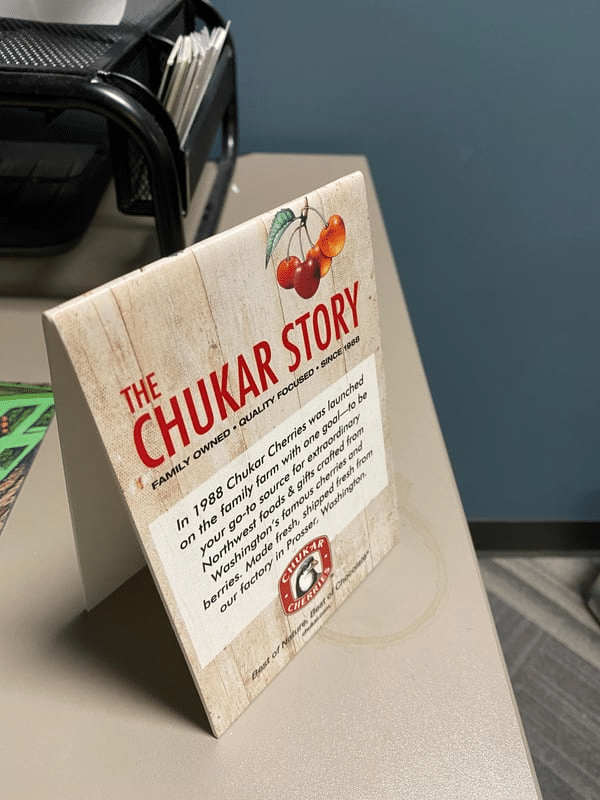The Benefits of Print Marketing
Print marketing is extremely effective at reaching a targeted audience in a tangible, cost-effective manner. It helps evoke a more emotional response, which triggers brand retention, and works complementary to digital advertising.
Let’s explore each of these topics in detail.
Tangible
Print provides a multisensory experience. Holding a brochure or flyer and flipping through pages helps readers connect with the content at a deeper level. There’s something more tangible about print.
When you put something in writing on a printed piece, there’s a permanence to it. It’s not easy to change, so what you’re saying needs to be accurate, and readers will hold you accountable. Consumers understand this instinctively, which is why printed materials generate a higher level of trust than other media types. 82% of people said they trust print advertising more than any other medium and twice that of digital ads.
Targeted Audience Reach
Today, finding your ideal prospects and delivering customized content at scale is easy.
Target prospects:
- With brochures when they visit your booth at trade shows
- By sending customized event invitations to high-value prospects
- By using personalized direct mail campaigns to qualified leads with specific job titles
There are many ways you can creatively use print to target prospects.
You can also use the same targeting tools for direct mail campaigns as digital ones. Build and segment prospect lists by age, location, company, interests, behavior, and more to deliver highly precise, personalized messaging.
Print also appeals to all demographic groups. In recent years, there’s been concern about younger consumers and business decision-makers moving exclusively to digital. That simply isn’t the case. According to research, 77% of Millennials pay attention to direct mail, 73% to retail inserts, 54% to catalogs, and 51% to magazines. 92% of 18 to 23-year-olds say they find it easier to read print than digital content.
Print allows you to target Millennials or any other audience segment with personalized print marketing.
Cost-Effectiveness
Technological advancements in printing in recent years have reduced costs, making printed materials extremely cost-effective. And you can typically get discounts when you buy in bulk as opposed to most other forms of marketing that have increasing costs for broader exposure.
You also aren’t competing with other businesses over the cost of exposure. If you’re advertising online, high-traffic keywords are up for bid. You only win if you pay more than your competitor. With print marketing materials, you get consistent and predictable pricing unaffected by anything your competitors are doing.
Better Comprehension and Response
Studies show that when people are reading printed materials, they are more focused. They’re not distracted by ads or notifications and hone in more on messages. People tend to read print more slowly and deliberately, aiding in understanding and retention.
A Temple University study also shows that there is also greater emotional engagement from print materials, which helps messages resonate with readers. This leads to better response rates. For example, direct mail has a response rate of up to nine times higher than other marketing strategies, such as email.
Complementary to Digital Marketing
When looking at the right marketing mix for your business, it’s important to recognize that you’re not in an either-or situation. You don’t have to choose exclusively digital, print, or any other medium.
Print and digital, for example, are highly compatible. Marketing campaigns that combine the best digital and print strategies are as much as 400% more effective.
Marketing has a cumulative effect. When you are consistent in your branding and messaging across marketing channels, everything works better by reinforcing your value proposition and building brand awareness.
Examples of Effective Print Marketing Strategies
There are many different types of print marketing approaches, and all of them can be effective when used creatively. Here are some examples of effective print marketing businesses use to attract B2B and B2C customers.
Direct Mail Campaigns
Direct mail remains a highly effective strategy for targeting customers. Consumers engage with 96% of direct mail, according to the Data & Marketing Association, higher than any other form of media.
People notice direct mail and take action. 92% of customers report going online to learn more about a business after receiving direct mail. 87% say direct mail has influenced them to make purchases.
One of the reasons direct mail campaigns have become an even more critical part of the marketing mix is the decrease in general volume. It’s still a popular and efficient use of print marketing. The US Postal Service reports that more than 66 billion pieces are sent annually, representing an 18% decrease from the high mark in 2016, making today’s direct mail marketing stand out more.
AlphaGraphics Seattle has created memorable and highly successful campaigns, such as the ones for Zillow Offers, Zillow’s home-buying unit, which leveraged exceptional creativity with eye-catching custom envelopes and offers personalized to the recipient. Bulk mail works well, but one-to-one mail generates a dramatically higher return.
Other examples of successful direct mail campaigns include community-engagement campaigns by governments and special-interest groups, such as this unique “community report mailer” we completed recently for the San Juan County Conservation Land Bank.

San Juan County Conservation Land Bank Printed by AlphaGraphics Seattle
Print Advertising in Relevant Publications
Print advertising in publications relevant to your target audience is a great way to get exposure to dedicated audiences. People already see value in a magazine or journal they subscribe to, adding some validity to your message. And you can customize your message to speak directly to readers.
Unlike digital ads that can change at a moment’s notice, print advertising is in writing, which inspires trust. Trust is the foundation of sales, especially for B2B buyers. Print ads also trigger the highest ROIs for print marketing, producing a 112% return on investment.
Print advertising is also surprisingly trackable. While you can’t click on it, you can use a unique URL, personalized landing page, call tracking number, or QR code to track response.
An effective strategy is to tie calls to action within print advertising to specific campaigns and then generate personalized follow-up mailings.
Event Marketing Materials
Brochures, flyers, catalogs, and other event marketing materials also make an impact. You can produce eye-catching materials that capture someone’s attention and provide the depth of information that you may not be able to do in digital or print ads. Many of these print materials get kept for long periods, creating longer and more lasting exposure.
Event marketing materials are effective, too. 85% of people reading brochures say they learned about a new business, and 61% of people have purchased products they see in brochures.
Signage is also a great way to brand an event and provide helpful information to attendees. For example, GeekWire’s annual GeekWire Awards event attracts nearly a thousand innovators, entrepreneurs, and tech leaders throughout the Northwest each spring. The graphics in the image below provided sponsor visibility and recognition at the main bar—a central focal point for this networking-heavy, high-visibility event.

Signage Printed and Installed by AlphaGraphics Seattle
‘Wall graphics are one of the most effective ways to provide branding themes in multiple different environments, such as these installed as part of a graphics package AlphaGraphics produced for a customer event by (now former) Seattle software company Chef.

Signage Printed and Installed by AlphaGraphics Seattle
Branded Promotional Items
Everybody likes free swag, right? That’s why marketers are forecast to spend more than $20 billion on promo products in the US in 2023.
Branded promotional items produce huge results. 85% of consumers say they remember brands that gave them products. Recall is highest for shirts or hats, but other promotional items also make an impression.
Branded promo items are kept for a long time, providing repeat exposure. 57% of consumers that get promotional products report they have kept some of them for more than five years. When items are worn or displayed, this exposure is also magnified because others see it. In some cases, this can also serve as an implied endorsement.
The most popular branded promotional items include:
- T-shirts and polo shirts
- Jackets
- Umbrellas
- USB drives
- Desk accessories
- Mugs and drinkware
- Bags
- Pens
Another effective way to make a mark is to provide practical branded apparel. For example, AlphaGraphics Seattle recently worked with a fishing industry client to execute a creative design onto high-quality American-made sweatshirts that AlphaGraphics sourced. These included “safety colors” that crews could wear on their boats.
Other effective branded promo items include coasters that were unique to a management training program and communicated the company’s brand values and purpose…

Branded Coasters Printed by AlphaGraphics Seattle

Branded Pennant Printed by AlphaGraphics Seattle
…or commemorative pennants produced as a giveaway for a client event hosted at a Mariners suite.
Signage and Location Items
Signage and in-store items play a big role in creating impressions — good or bad. First impressions count, so you need to put your best foot forward. Signs can be for branding, visibility, or to convey important information about your business.
The combination of graphics and print marketing can create an emotional appeal to drive customers into your stores.

Store Signage Printed by AlphaGraphics Seattle
It’s not just the exterior signage that matters, either. Wall graphics, point-of-purchase displays, banners, and menus all play a role in how consumers feel about your products or services to enhance or detract from the customer experience.
Some other examples of effective marketing using signage and location items include:
- Table talkers
- Counter cards
- Display cases
- Room markers
- Directional and wayfinding signage
Here are a few examples of in-store signage that help create an impression, such as highlighting sustainability for Willamette valley wines.

Product Display Printed by AlphaGraphics Seattle
Table cards can tell a story and explain your unique value proposition to customers.

Table Card Printed Printed on Sintra and heat bent by AlphaGraphics Seattle
How to Effectively Incorporate Print into your Marketing Mix
So, how do you incorporate print into your marketing mix effectively? Here are a few tips to do it right.
Identify the Right Audience for Your Print Campaign
One of the keys to any marketing campaign is to analyze your ideal customers and find the right audience for your message. Getting your message in front of the right audience is essential for it to work efficiently and cost-effectively.
When you do not target the right audience, you waste time and effort. It’s estimated that $37B+ in marketing budgets globally is wasted each year. Google reports that 56% of ad impressions are never even seen by consumers.
So, the first step in creating an effective marketing strategy is to obtain a deep understanding of who you are trying to reach. This information should define every aspect of your marketing execution so you can focus your efforts on optimal performance.
A target audience is the group of consumers you believe require what you’re selling, have an interest in solving a problem or improving quality, and have the financial ability to make a purchase.
Identify your target audience by following these steps:
- Examine your current customers
Look for common traits and patterns of your best customers. Finding commonalities can help narrow your marketing, such as certain demographics, behaviors, types and sizes of companies, and purchasing patterns. This helps you create a picture of your best customers and ideal buyers. This information also helps inform campaigns and target messaging.Your CRM can yield a lot of this data, and conversations with your sales team can help flush it out. - Research the market and your competitors
Understand the most likely prospects within your market and learn who your competitors are targeting. This can also help you find underserved niches or places where your unique selling proposition (USP) can be more effective.You should also be aware of industry trends impacting buyer behavior, such as seasonal patterns or evolving consumer habits. - Analyze the data
Use the data you’ve gathered to create buyer personas. These are semi-fictional groups that best fit the attributes of your target market.You’ll likely have multiple personas that have different needs. For example, the CFO at a business may be more interested in profitability, while a line manager may be more focused on productivity and efficiency. Segmenting your audience into different personas helps you zero in on the best targets for specific marketing campaigns.
Measuring the ROI of Your Print Marketing Efforts
Businessman John Wanamaker once said:
“Half the money I spend on advertising is wasted; the trouble is I don’t know which half.”
Wanamaker said this in the early 1900s, well before today’s incredible marketing clutter. But he’s still right. Without measuring your print marketing, it’s impossible to tell what’s working.
Your marketing plan should include tracking campaigns to ensure you are getting a positive ROI. Before you can do that, you need to first set your marketing goals and then define the metrics for how you will determine success.
Tracking URLs, trackable phone numbers, and custom landing pages can help you measure your print materials’ effectiveness against your goals. Creating specific offers targeted to different audience segments can also help you measure success. For example, coupons and unique promotions can help you see what works best.
Personalized URLs can drive traffic from your print materials to a web page that exists for only that customer or a particular group of customers. With marketing automation, you can even tie in past behavior to create a dynamic landing page customized to specific buyers.
However you choose to track results, you must put in place measurement processes and determine KPIs before you launch campaigns.
Integrating Print with Your Digital Marketing Efforts
You should always have a consistent look and feel for your marketing. This includes consistency in logos and logo treatments, colors, fonts, styles, brand voice, and more.
However, the integration goes beyond that.
The best marketing campaigns will work seamlessly across channels. Today’s buyers consume a tremendous amount of media in all forms. When you combine print with your digital marketing in a cohesive way, you can compound the impact of your marketing. Direct mail, paired with digital ads, shows conversion rates that are 28% higher.
Creating a cohesive customer experience to drive buyers through the sales funnel is essential for effective marketing. Prospects may start with a brochure or postcard but then want more information. You’re missing a massive opportunity if you’re not driving them online. You may pique their interest only to find they’re heading to Google rather than your website.
Today, there are multiple ways to drive integration. QR codes can track conversions to online traffic. Some brands use augmented reality (AR) to bring print pieces to life. For example, IKEA lets shoppers point their smartphone at a catalog page and see how products would look in their physical environment.
It works the other way, too.
You can use your online marketing to capture leads and follow up with direct mail or product information kits. Businesses that offer promo items, brochures, or sales collateral after inquiries deliver as much as seven times higher conversion rates.
Companies that send follow-up emails within a week after a direct mail campaign see response rates increase by more than 60%.
It’s really a great pairing when you combine digital and print marketing. 44% of customers report visiting a company’s website after getting direct mail or other print collateral from a company — just one more reason why consistency is crucial.
Staying Up-to-Date on the Latest Print Marketing Trends
Print marketing continues to evolve. New strategies and technology are creating additional ways to leverage the power of print marketing.
Variable data printing (VDP) lets you scale personalization using customer data to create customized messages for each recipient or create coupons or offers with unique tracking codes.
Variable imaging can personalize the visual elements as well. This AlphaGraphics Seattle postcard campaign for the 28,000 alums at the University of Idaho embedded every recipient’s name into their football jersey on the front of the postcard.

Custom Postcard Printed by AlphaGraphics Seattle
There are also all sorts of new finishing options, textures, laminates, coatings, and techniques to enhance your print materials and make them stand out.
Staying up-to-date on the latest print marketing trends can help you find new marketing strategies to make print campaigns even more effective.
DOWNLOAD THE GUIDE
Conclusion
Print marketing provides a wealth of benefits. Creating tangible and lasting print pieces can aid in brand exposure and retention, improve conversion rates, and be highly targeted.
Print marketing needs to be part of your marketing mix. An effective and remarkably cost-efficient way to market your products and services, print marketing yields big results.

